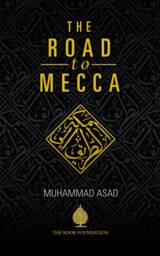Vol. 1 of 2
Asad, Muhammad. The Road to Mecca. USA. Fons Vitae. 375 pp. £7.63 (PB) ISBN 188-775-237-4
Reviewed by:
Abdul Hai.
Classic rihla (travel) literature like the journey of Ibn Battuta (1307-1369) or Marco Polo (1254-1324) is no doubt an exceptional narrative of events, experiences, and landscapes. The readers are fascinated by the narrations of such travelers. However, modern readers cannot actually relate to time and space due to the distance from the milieu of the above-mentioned authors. The Road to Mecca is an exception as it has all the flavors of Ibn Battuta and Marco Polo’s travels but the modern reader can significantly picture their attachment to Asad’s narration due to the closeness of time between the readers and the author.
The Road to Mecca is the travel log of the influential Muhammad Asad (1900-1992) who was born to a Jewish family in Lemberg, Galicia, then part of the Austro-Hungarian Empire. Asad’s journey began with a sense of an inner battle within himself. He was disillusioned with his life and environment. This journey ended with the satisfaction of discovering Islam, though it was not a “deliberate search for faith…” but rather that “faith came upon [him]…”
Asad’s journey takes us through Iran, Libya, Saudi Arabia, Syria, Afghanistan, Palestine and Egypt, where he met and conversed with leaders of the Muslim world and became part of the battle against the colonial power. Asad, throughout the book, is in a continuous conversation with himself. In many ways, the book is a travel log of other actors like Zayd, Asad’s faithful companion, whose name does not escape from the book. Zayd can also be considered the second Asad in the rihla.
Asad’s experience with different cultures, behaviours, and habits of the people of those countries helped him to build an inner connection with himself and created a sense of belonging, something which he argues was missing in the West.
To categorise the book into a particular subject is rather a difficult task as it explores the human psyche, which permeates intricate discussions of a philosophical, psychological, sociological, and historical nature. With these discussions, coupled with his romantic writing style, Asad creates a sense of mystical connection with the world.
Asad can easily be described as a lover of cultures, an adventurer, a ‘civilisationist’, a journalist, a statesman, and a visionary. Asad uses all these characteristics in different parts of the book to discover himself and to recreate what he calls pure Islam.
The two main characteristics of Asad’s book, which are very unique, are the layout and the language. The layout of the book is rather difficult to follow but Asad was fully aware of this. To fully appreciate the book, the reader must gather Asad’s experiences and events which are scattered throughout the book into one narrative. It is only then that the reader will be able to share the thoughts, emotions and experiences that Asad felt through his journey.
The book follows a romantic style of writing and uses many metaphors to describe objects, space, imagery and cultural narratives. One is forced to say the book goes too far in using metaphors, objects and space but it is precisely those things that help the reader to appreciate Asad’s writing and narratives.
The Road to Mecca is divided into twelve chapters. Asad starts the book with a title named story of a story. Here, Asad describes the reasons for this and how he started writing the book. This, however, is not part of the twelve chapters. All of the twelve chapters are connected in one way and are yet disconnected in another way because of different political, social and environmental events that Asad goes through.
Each chapter, in some form or shape, has contributed towards Asad’s transformation. Asad uses letters and events to talk about countries’ history and about some personalities. For example, in chapter nine (Persian Letter), Asad receives a letter from one of his guides in Iran named Ali Agha. He uses the letter as a tool to explore the history of Iran. And yet in chapter eleven (Jihad) is used to discuss the history of Libya and the life and work of Omar al-Mukhtar and his Senussi movement.
The book narrates Asad’s journey and the journey of others. Asad details an almost visual picture of the landscape, the socio-political atmosphere of the place, and the people he visits. In each chapter, Asad never fails to compare and contrast the events and social activities of his experiences with the western world.
Each chapter creates this feeling of walking into a no-man’s land and yet Asad seems to know each feature in detail and is able to directly connect to his emotions and world view as if this no-man’s land is able to answer his burning question; what is the purpose of life?.
If there was such a thing as a to-do-list before death, then reading The Road to Mecca must be added to the list. The Road to Mecca has all the adventures of Indiana Jones but without the orientalist narrative of the others. It is a book that rejuvenates the pleasure of reading, stimulates the imagination, removes boredom and procrastination. It is a book of history as much as it is a book on human sociology and, most importantly, it is a book that will take you away from the madness of the modern world to a world of serenity.


Add Comment